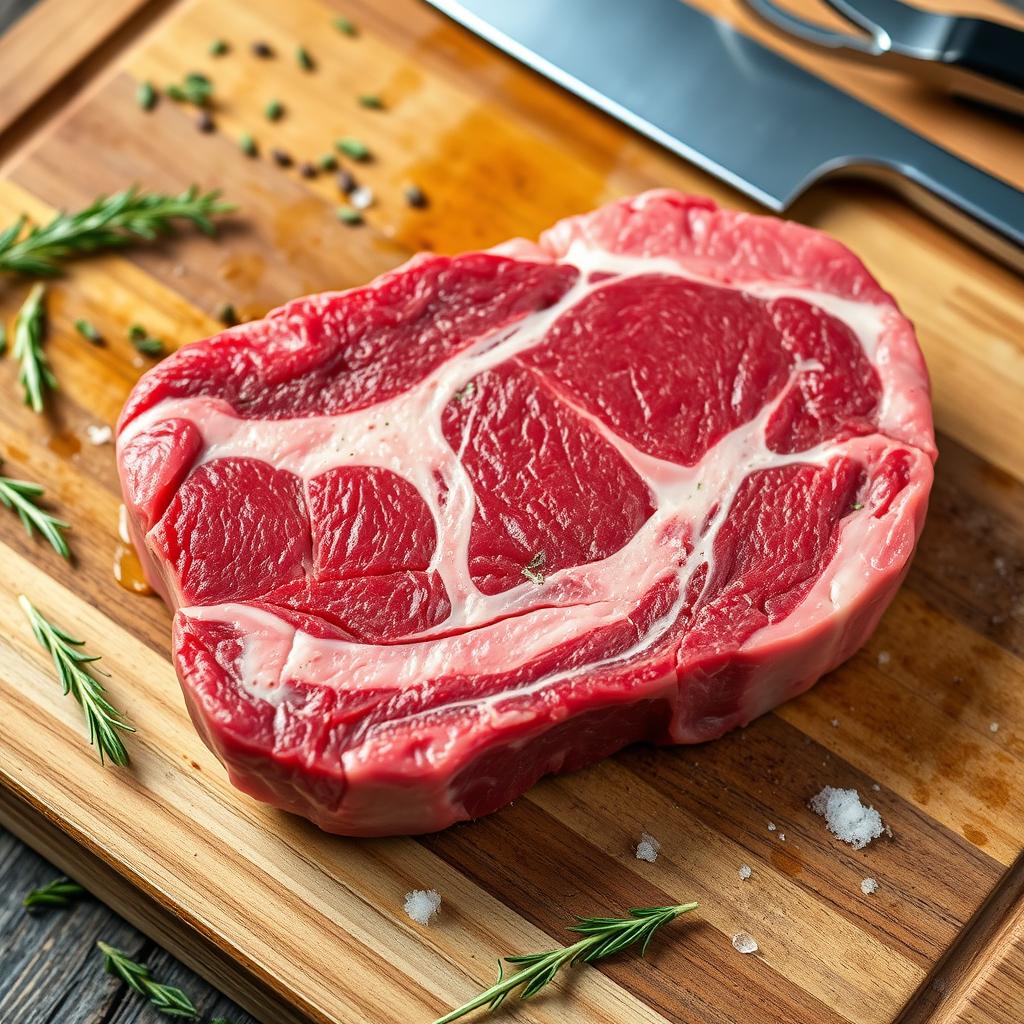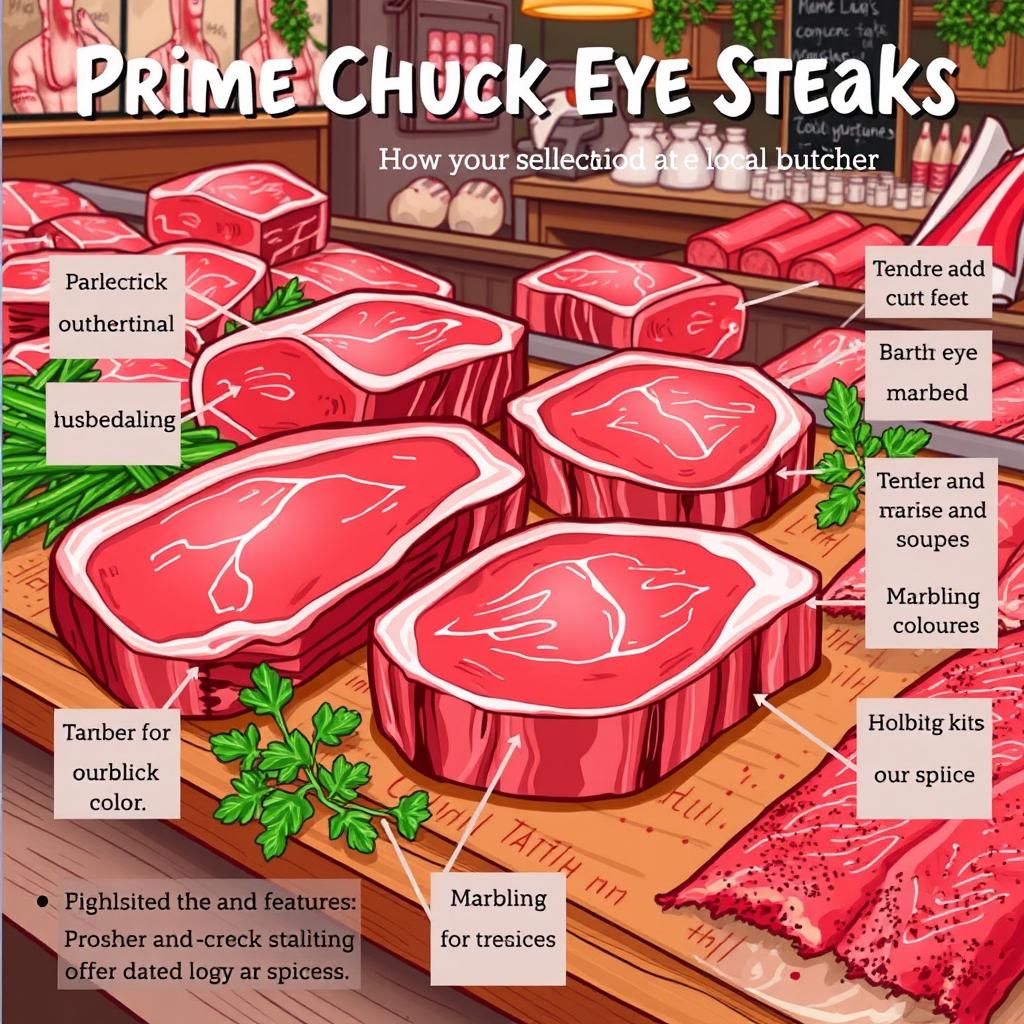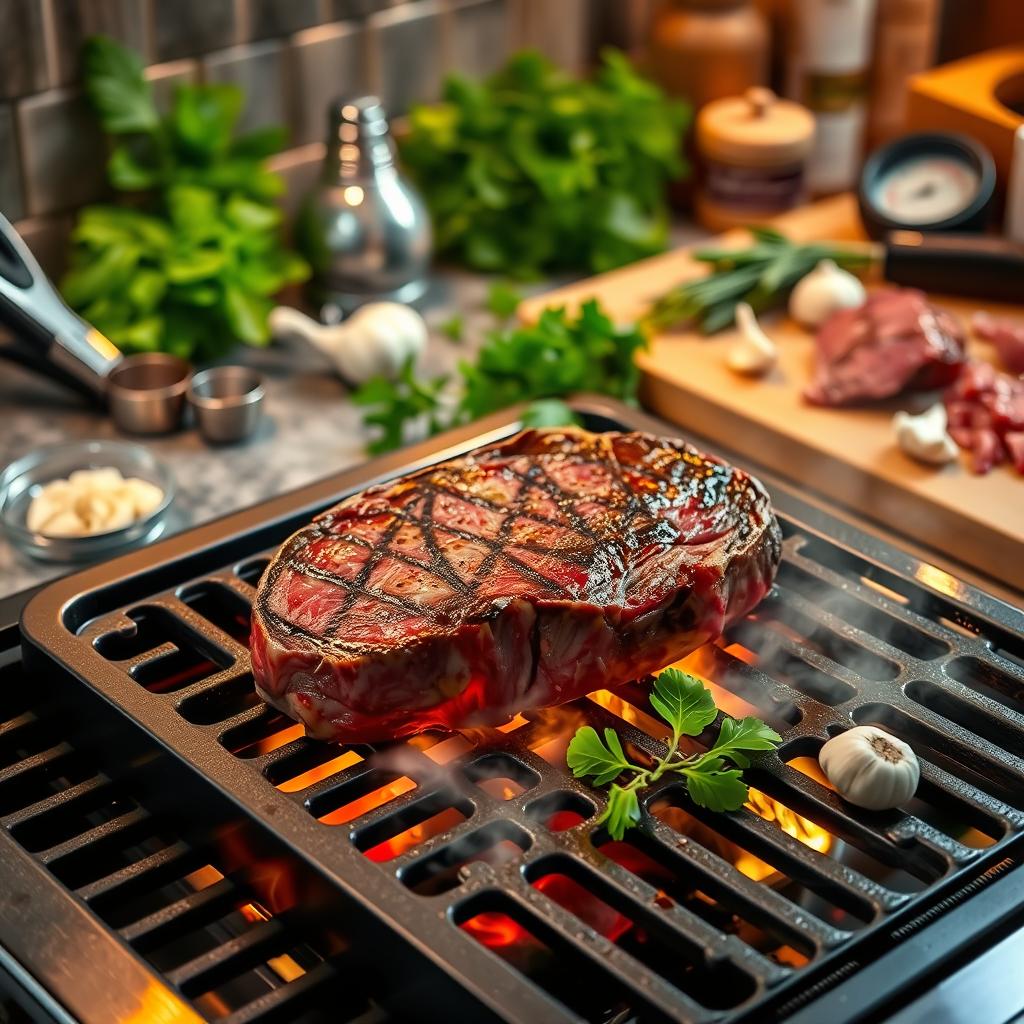Want to cook a tasty beef chuck eye steak without spending a lot? This cut is known as the “poor man’s ribeye” because it tastes great but costs less. It’s perfect for both home cooks and grilling fans, making your meals special and your guests happy.
The chuck eye steak is a great choice for those who love tender and juicy beef. It’s not as pricey as other cuts but still packs a lot of flavor. Learning how to pick, season, and cook your steak will make your meals even better.
Key Takeaways
- Chuck eye steak offers exceptional flavor at an affordable price
- Proper selection and preparation are crucial for perfect results
- Multiple cooking methods can be used successfully
- Understanding meat temperature is key to achieving desired doneness
- Resting the steak after cooking ensures maximum tenderness
Understanding Chuck Eye Steak: The Poor Man’s Ribeye
Beef chuck has a hidden gem that steak lovers are discovering: the chuck eye roll. This affordable cut offers a luxurious eating experience without breaking the bank. Often called the “poor man’s ribeye,” chuck eye steak delivers exceptional flavor at a fraction of the price of its more expensive counterpart.

Difference Between Chuck Eye and Ribeye
While ribeye steaks are prized for their tenderness and marbling, chuck eye steak comes from a similar muscle group. The primary difference lies in their location on the beef chuck. You’ll find chuck eye steak located just next to the ribeye section, which explains its remarkably similar taste profile.
- Price point: Significantly cheaper than ribeye
- Flavor: Rich and beefy
- Tenderness: Slightly less tender than ribeye
Location and Muscle Structure
The chuck eye steak is cut from the shoulder region of the cow. This specific muscle area provides a unique combination of flavor and texture that makes it stand out among other beef cuts. Its proximity to the ribeye section means it shares many characteristics with the more expensive steak.
Flavor Profile and Marbling
What sets chuck eye steak apart is its impressive marbling. The intricate fat patterns running through the meat ensure a juicy, flavorful experience. Meat enthusiasts appreciate this cut for its robust beef flavor and relatively tender texture. When prepared correctly, it can rival more expensive steaks in taste and satisfaction.
“Chuck eye steak proves that great flavor doesn’t always come with a high price tag.” – Professional Chef
Selecting the Best Chuck Eye Steak at Your Local Butcher
Choosing the perfect boneless chuck eye steak can make your cooking amazing. The beef chuck roast is a great value that many miss. Learning why chuck eye steaks are cheap reveals a hidden treasure.

- Look for deep red coloration with consistent marbling
- Check for firm texture without excessive moisture
- Inspect the fat distribution across the cut
- Ask about the specific muscle section of the chuck
“The secret to an amazing steak starts with selecting the right cut” – Professional Butcher’s Advice
Looking closely at the steak is key. Butchers say to check for even fat streaks for flavor and tenderness. A top cut has white fat marbling all over the muscle.
| Steak Characteristic | Ideal Qualities | What to Avoid |
|---|---|---|
| Color | Deep red | Brown or grayish tint |
| Marbling | Consistent white fat streaks | Large chunks of fat |
| Texture | Firm, slightly springy | Mushy or overly soft |
Pro tip: Get to know your local butcher. They can share tips on choosing the best cuts. They might save the best steaks for their regulars.
Essential Tools and Equipment for Cooking Chuck Eye Steak
To make the perfect chuck eye steak, you need more than just great meat. The right tools and equipment can turn a simple chuck tender steak into a meal fit for a restaurant. Knowing your kitchen tools is key to getting the best results with your chuck roast.
Choosing the right equipment helps answer if chuck steak is high quality. With the right tools, even this affordable cut can be a tasty treat.
Required Kitchen Equipment
- Cast iron skillet for even heat distribution
- Heavy-bottomed grill pan or outdoor grill
- Sharp chef’s knife for precise cutting
- Cutting board with juice groove
- Tongs for safe meat handling
Temperature Control Tools
| Tool | Purpose | Recommended Type |
|---|---|---|
| Meat Thermometer | Ensure proper internal temperature | Digital instant-read |
| Oven Thermometer | Check oven accuracy | Analog hanging model |
| Infrared Thermometer | Measure surface temperature | Non-contact digital |
Seasonings and Marinades
Your chuck eye steak’s taste comes from the right seasonings. Make sure you have these essentials:
- Kosher salt
- Freshly ground black pepper
- Garlic powder
- Olive oil
- Fresh herbs like rosemary and thyme
“The right tools transform an average steak into a culinary masterpiece.” – Professional Chef
Investing in quality kitchen tools means you can always make a delicious chuck eye steak. It will be as good as what you find in restaurants.
Preparing Your Chuck Eye Steak Before Cooking
Getting your beef chuck ready for cooking is key to a delicious chuck eye roast. The right prep can turn a simple cut into a memorable meal.
Before cooking, take your chuck eye steak out of the fridge. Let it sit at room temperature for 30-45 minutes. This step ensures even cooking and keeps the meat juicy.
- Remove the steak from packaging
- Pat the meat dry with paper towels
- Inspect for any excess fat or unwanted membrane
The chuck eye steak is known for its great flavor and tenderness. Trim off any extra fat, but keep a thin layer for extra richness.
“Proper preparation is the secret to transforming a good steak into a great one.” – Professional Chef
Use a sharp knife to remove silver skin or tough tissue. Clean cuts ensure better texture and more even cooking. This detail makes your steak stand out.
- Use sharp kitchen scissors or a boning knife
- Remove visible silverskin gently
- Keep the natural marbling intact
The secret to a perfect chuck eye roast is to respect the meat’s natural qualities. By following these steps, you’ll get a delicious and tender steak that’s as good as more expensive cuts.
Seasoning Techniques for Maximum Flavor
Turning a good chuck eye steak into a great meal starts with seasoning. Your beef chuck eye needs careful attention to bring out its rich flavors. The right seasoning can make this affordable cut truly special.
Seasoning a chuck tender means understanding its unique traits. You want to boost its natural beef taste and create a tasty crust. This crust helps keep the steak juicy.
Dry Rub Options for Chuck Eye Steak
A good dry rub can make a big difference in cooking chuck steak. Here are some great flavor mixes:
- Classic Steakhouse Rub:
- 2 tbsp kosher salt
- 1 tbsp black pepper
- 1 tsp garlic powder
- 1 tsp smoked paprika
- Southwestern Kick:
- 1 tbsp chili powder
- 1 tsp cumin
- 1 tsp dried oregano
- Salt and pepper to taste
Marinade Magic
Marinades can turn your beef chuck eye into a tender, flavorful dish. The secret is finding the right balance of acid, oil, and spices.
“Great marinades are about harmony between ingredients, not overpowering the natural beef flavor.” – Professional Chef
Timing and Temperature Guidelines
Timing is key when seasoning your chuck eye steak. Use dry rubs 30-60 minutes before cooking to let flavors soak in. For marinades, 2-4 hours is the max to avoid toughening the meat.
Pro tip: Always pat your steak dry before seasoning. This ensures a perfect sear and better flavor.
Different Methods to Cook Chuck Eye Steak
Discovering the perfect cooking method for your chuck eye steak can make it taste like a restaurant meal. Each method has its own benefits for enhancing the rich flavors of this poor man’s ribeye.
When preparing a chuck eye steak, you have several delicious cooking options:
- Grilling: Creates a perfect char and smoky flavor
- Pan-searing: Delivers a crispy exterior and juicy interior
- Oven-roasting: Ensures even cooking for larger cuts
- Sous vide: Provides precise temperature control
Grilling is the most popular method for cooking chuck eye steak. It uses high heat to caramelize the surface and keep the inside tender. Pro tip: Let your beef chuck roast come to room temperature before cooking for best results.
| Cooking Method | Cooking Time | Difficulty Level |
|---|---|---|
| Grilling | 8-12 minutes | Easy |
| Pan-searing | 6-10 minutes | Medium |
| Oven-roasting | 15-25 minutes | Medium |
| Sous vide | 1-4 hours | Advanced |
“The key to a great chuck eye steak is understanding its unique characteristics and selecting the right cooking method.”
Many home chefs wonder: is chuck eye a good steak? Absolutely! With the right technique, this budget-friendly cut can rival more expensive options. Each method brings out different qualities in the meat, so experiment to find your favorite.
Temperature Guide and Cooking Times
Learning to cook the perfect chuck eye steak is all about mastering cooking temperatures and doneness levels. This cut of beef is a budget-friendly option, similar to ribeye. It needs precise cooking to reach its full flavor.
Understanding Doneness Levels
Getting the right doneness is crucial for a great chuck tender steak. Each level of doneness changes how the meat tastes and feels:
- Rare (125°F): Cool red center, very soft texture
- Medium Rare (135°F): Warm red center, slightly firmer
- Medium (145°F): Pink center with more firmness
- Medium Well (150°F): Slight pink center
- Well Done (160°F): No pink, completely cooked through
Internal Temperature Reference Chart
| Doneness Level | Internal Temperature | Cooking Recommendation |
|---|---|---|
| Rare | 125°F | Remove from heat at 120°F |
| Medium Rare | 135°F | Remove from heat at 130°F |
| Medium | 145°F | Remove from heat at 140°F |
| Medium Well | 150°F | Remove from heat at 145°F |
| Well Done | 160°F | Remove from heat at 155°F |
Chuck eye steak is also known as the “poor man’s ribeye”. Always use a meat thermometer for accurate readings and perfect results.
“Precision is key when cooking chuck eye steak. The right temperature can make all the difference between a tough and tender meal.”
Resting and Serving Your Chuck Eye Steak
After cooking your boneless chuck eye steak, it’s important to let it rest. This step helps the steak stay juicy and flavorful. It allows the juices inside the meat to spread out evenly.
The resting time depends on how thick the steak is. Here are some general guidelines:
- Thin cuts (½ inch): Rest for 3-5 minutes
- Medium cuts (1 inch): Rest for 5-7 minutes
- Thick cuts (1½ inches): Rest for 8-10 minutes
“Patience is key when resting your steak. The wait ensures every bite is packed with flavor.” – Professional Chef
When wondering why chuck eye steaks are so cheap, remember that proper resting technique can elevate this affordable cut to restaurant-quality deliciousness. Cover the steak loosely with aluminum foil during resting to keep it warm without trapping steam.
Serving suggestions for your chuck eye steak include:
- Slice against the grain for maximum tenderness
- Pair with roasted vegetables
- Complement with a bold red wine
Pro tip: Let your steak reach room temperature before slicing to preserve its juicy interior and rich flavor profile.
Conclusion
Learning to cook chuck eye steak makes a budget-friendly cut of beef taste like a fancy restaurant meal. This beef is a tasty substitute for pricier ribeye steaks, offering great flavor and softness. By following the guide, you can improve your cooking and wow your loved ones.
The secret to a great chuck eye steak is choosing the right one, preparing it well, and cooking it just right. Whether you’re new to cooking or have been doing it for years, these tips will help you get the most out of this versatile meat. Remember, the more you cook, the better you’ll get.
Try different seasonings, cooking ways, and how well done you like it to find your favorite way to cook chuck eye steak. Don’t hesitate to try new things and make the recipe your own. With the right approach, you can make a steak that’s as good as any restaurant’s, right in your kitchen.
Start your journey to becoming a chuck eye steak master. Your dedication to learning and improving will lead to unforgettable meals. These meals will show off the amazing taste and value of this affordable beef cut.
FAQ
What is a chuck eye steak?
Chuck eye steak is a tasty and affordable beef cut. It’s near the ribeye and costs less. It’s from the cow’s shoulder and tastes rich and tender when cooked right.
Is chuck eye steak a good cut of meat?
Yes, it’s great for those watching their budget. It tastes like a ribeye but costs less. It’s not as tender as some cuts, but it’s delicious with the right seasoning and cooking.
What’s the best way to cook a chuck eye steak?
Pan-searing, grilling, and oven-roasting are top choices. Make sure it’s at room temperature before cooking. Season well and cook to your liking. Medium-rare to medium is usually best.
Why are chuck eye steaks so cheap?
They’re from the cow’s shoulder, not as sought-after as ribeye or filet mignon. They’re less known and marketed, keeping prices down. But, they’re not lower in quality; they’re just more affordable.
How long should I cook a chuck eye steak?
Cooking time varies by steak thickness and desired doneness. For a 1-inch steak:
– Medium-rare: 3-4 minutes per side
– Medium: 4-5 minutes per side
Use a meat thermometer for the right internal temperature (135°F for medium-rare, 145°F for medium).
What are some good seasonings for chuck eye steak?
It goes well with many seasonings. Try:
– Salt and black pepper
– Garlic powder
– Rosemary and thyme
– Montreal steak seasoning
– Olive oil and herbs
A simple salt and pepper rub often brings out the best flavor.
Can I use chuck eye steak for other recipes?
Absolutely! It’s versatile and works in many dishes. Try it in stir-fries, beef stroganoff, fajitas, and stews. Its rich flavor is perfect for various cooking styles.
How should I store chuck eye steak?
Keep it in the coldest part of your fridge at 40°F or below. Use within 3-5 days if raw. Freeze for up to 12 months if not cooking right away. Wrap tightly in freezer paper or vacuum-seal to avoid freezer burn.

